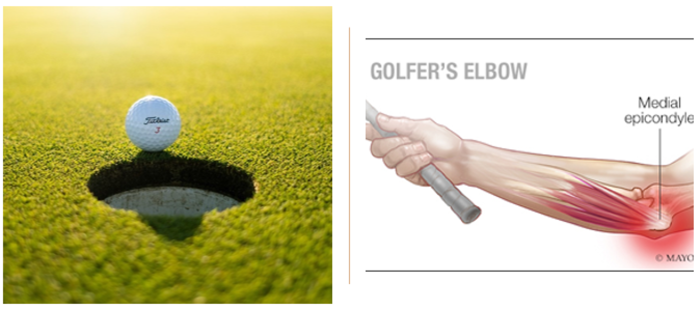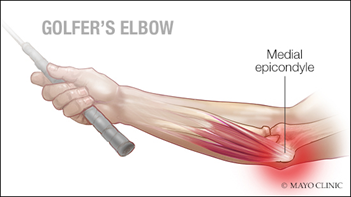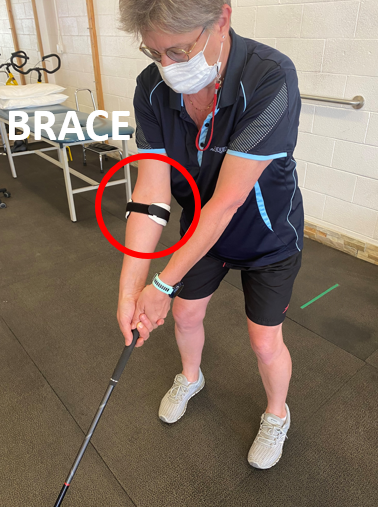
Are You Suffering From Golfer’s Elbow?
- Suffering from Golfer’s Elbow is the most common form of medial elbow pain.
- Often caused by overuse of the medial muscles of the forearm.
- Managed effectively, it does not have to ruin your game or prevent you from working.
- Rest, followed by progressive loading exercises will help resolve your pain.
What is Golfer’s Elbow?
Golfer’s elbow, or medial epicondylopathy, is the most common cause of medial (inside) elbow pain and is usually seen in those ages 35-55 in their dominant arm. It is a form of tendinopathy that causes pain and inflammation in the tendons connecting your forearm and elbow. When you repeatedly use your wrist and arm to bend, grasp or twist things, your tendons develop tiny tears/strain that can cause wrist, elbow and forearm pain. You don’t have to play golf to be suffering from Golfer’s Elbow. Other symptoms could also include;
- Aching pain in your forearm or wrist.
- Pain when you try to make a fist.
- Decreased grip strength.
- Tingling in your hand.
- Numbness in your hand.

What causes Golfer’s Elbow?
Golfer’s elbow happens when you repeatedly use your wrist and arm to bend, grasp or twist things. Over time, the tendons that connect your forearm and elbow develop tiny tears that can cause wrist, elbow and forearm pain.
How to Manage Golfer’s Elbow
The main goal of the conservative treatment is to relieve pain and reduce inflammation. These two things will help to achieve a proper rehabilitation and later, a return to usual activities.
Phase 1: Easing of Symptoms
It is essential to significantly reduce and/or modify aggravating factors and follow the RICE principle. Rest. Ice. Compression & Elevate. This will help reduce the stress placed on and around the medial epicondyle and allow a quicker recovery of the injured tissue – the quicker your suffering from golfer’s elbow eases, the sooner you can start loading and strengthening the elbow. Minimizing aggravating activities is important to allow the injured site to repair and for the potential swelling to subside. However, this may be difficult for those with occupations requiring certain movements. For these scenarios, taping or bracing the elbow may be of benefit, icing afterwards and/or anti-inflammatory medication from a doctor may help also.

Phase 2: Progressive Loading & Strengthening Program
Rehabilitation of tendinopathies takes time, compliance, and progressive loading of the tissues. Once improvement is seen in Phase 1, we can begin Phase 2. The first goal of phase 2 is to re-establish full pain free wrist and elbow range of motion. This is followed by progressive strengthening.
Here are three examples of progressive loading/strengthening exercises.
Eccentric exercise – Eccentric exercise has been proven to benefit conditions such as Achilles and patellar tendinopathies – golfer’s elbow is no different.
Forearm twists – When applying a loading program to a golfer’s elbow both wrist flexion and forearm pronation should be included. Initially, you can start with a water bottle and progress your weight via reducing the grip size, increasing the weight, or increasing the length of the object you’re rotating with your forearm.
TheraBand FlexBar strengthening – Another great exercise to progressively load the medial muscles of your wrist/forearm.
With each loading exercise the aim is to start with a light weight that allows for pain free full range of motion and progress that weight/resistance roughly 10% each week. Performing around 3 sets of 12-15 reps 1-2x/day for 5 days/weeks
Phase 3: Gradual return to normal activities
As pain resolves and strength returns it is important to gradually return to your sport and normal activities. It may also be necessary to have a Physiotherapist or Sport coach assess your equipment and technique to understand to initial cause of the Golfer’s Elbow and prevent future reoccurrences.
If you developed golfer’s elbow on the job, wearing a brace might help by giving your wrist and elbow additional support so your tendons can heal. You might also try building in breaks when you can do gentle stretches or simply rest your arm.

Differential Diagnosis
When diagnosing a medial epicondylopathy, your Physiotherapist always has to consider other pathologies such as;
- C6/7 radiculopathy (i.e symptoms referring from neck)
- Cubital tunnel syndrome
- Ulnar or median neuropathy
- Ulnar neuritis
- Anterior interosseous nerve entrapment
- Ligamentous injury
- Arthritis
FAQ
Q: What’s the difference between tennis elbow and golfer’s elbow?
A: Like golfer’s elbow, tennis elbow does not necessarily result from playing that sport. But rather is caused by the repeated overuse of your wrist and arm muscles. The difference is tennis elbow hurts on the outside of your elbow.
Q: What can I expect if I have this condition?
A: Prognosis for golfer’s elbow is favourable. Most clients with golfer’s elbow will have a full return to activities, work, sport or recreational pursuits – particularly if they were receiving help from a health professional and/or have been diligent with their acute management, rest and a progressive exercise program.
FOR A THOROUGH ASSESSMENT AND DETAILED PLAN OF CARE TO RESOLVE YOUR PAIN,
CALL LIQUIDGYM 613-820-8228
TO HAVE AN APPOINTMENT WITH
ONE OF OUR THERAPISTS!
Reference
- Cleveland Clinic. Golfer’s Elbow (Medial Epicondylitis). (April 28, 2022) Retrieved from; https://my.clevelandclinic.org/health/diseases/21711-golfers-elbow-medial-epicondylitis
- Medial Epicondyle Tendinopathy. (April 28, 2022) Retrieved from; https://www.physio-pedia.com/Medial_Epicondyle_Tendinopathy?
Author:
Drew Murray
Physiotherapist